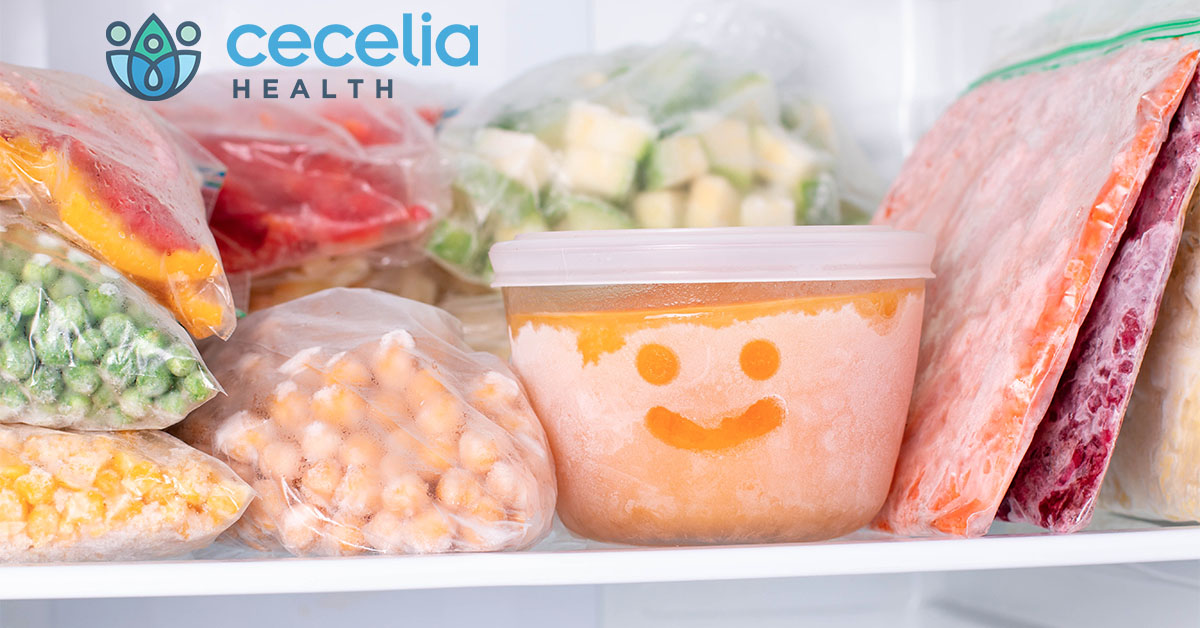Eating healthy and creating nutritious meals for diabetes management does not have to be difficult. With a bit of planning and the right resources you can get in the habit of eating well regularly. One of the best ways to encourage preparation of meals and snacks at home is making sure that you have plenty of ingredients readily available. In previous posts, we have already covered how to stock your pantry and your fridge with smart choices. Your freezer is yet another place to keep some healthy items on hand for easy meal planning. Read on to learn about how to utilize your freezer for healthy eating with diabetes.
Vegetables
A variety of vegetables, namely the non-starchy ones, should be the mainstay of your meals to promote blood sugar stability and management, as well as weight maintenance . Aiming to fill up half your plate with non-starchy vegetables, helps to increase your fiber, vitamin and mineral intake, without unnecessary carbs and calories. Frozen vegetables are great to keep in your fridge to ensure you always have veggies to add to your meals. High fiber starchy veggies, like corn and peas are also healthy choices when eating in measured portions, like a ½ cup serving. Some tips for using frozen veggies include:
- Keep bags of frozen pre cut veggies such as broccoli, cauliflower, green beans and mixed medleys to have on hand to steam for quick sides
- Add frozen veggies to soups to increase your daily vegetable intake
- Frozen cauliflower “rice “makes a great grain alternative in soups, stews and stir fries
- If you have extra fresh veggies that you do not have time to eat up, cook them al-dente and freeze them for later use
Frozen fruits
In addition to fresh, frozen is another great way to enjoy fruits. Frozen fruits are a nice way to be able to enjoy your favorite fruits year-round, even when they are not in season as fresh produce. Like vegetables, fruits are also packed with fiber, vitamins and minerals and can be part of eating for blood sugar stability and management, when eaten in reasonable portions. Try:
- Blend your favorite fruits into smoothies for quick meal replacements
- Snack on frozen grapes, blueberries, or banana slices for a refreshing naturally sweet treat
- Add thawed frozen berries to pancakes and quick bread recipes, or stir them into Greek yogurt or oatmeal
- Cut up and freeze overripe fruit to use in the above ways and to minimize food waste
Frozen meat and seafood
Keeping frozen lean meats like chicken breast, ground turkey as well as fish and shrimp in your freezer is a great way to make sure you always have healthy protein sources available to add to your meals. Suggestions include
- Chicken and fish can be thawed and cooked or cooked straight from the freezer (though you will need to add extra minutes when heating) as part of your favorite recipes, like soups, stews, stir fries and more
- Frozen ground turkey meatballs and patties can be cooked or barbequed to make great main dishes
- If you buy fresh meat, poultry and seafood in bulk, you can wrap individual pieces and freeze for later use
Plant based proteins like veggie burgers, edamame, and nuts
In addition to meats, keeping plant-based proteins in your freezer are also great options to have on hand for healthy meals. For meat alternatives, look for minimally processed varieties with less additives and sodium. Good ideas are:
- Stock frozen veggie burgers and textured vegetable crumbles to use as a lower fat alternative to hamburgers and ground beef in recipes
- Keep frozen shelled or in pod edamame to be able to quickly steam or boil for a high fiber and protein snack
- Buy nuts in bulk and freeze the extras to extend the shelf life and have them available for snacks, to add to salads and stir fries
Low sugar fruit pops and other healthy desserts
If you get cravings for sweets, buying frozen pre-portioned desserts or freezing extra portions or baked goods are great ways to help control carbohydrate intake, but also have your cake and eat it too. Examples include:
- Keep low sugar popsicles, or make your own with low sugar fruit juices to have as a refreshing sweet treat
- Try baking whole grain cookies and quick breads and then packing in individual serving sizes to freeze, so you can thaw one out for a portion-controlled treat
Whole grains and starchy vegetables
High fiber whole grains and starchy vegetables don’t have to just be stored in the pantry, you can keep some in your freezer too! Try adding some of these healthy frozen options at meals:
- Stock frozen whole grain waffles to toast and top with peanut butter or cottage cheese and fruit for a quick healthy breakfast
- Keep frozen brown rice to microwave as a quick side or to add to soups, stews and stir fries
- Buy frozen butternut squash and sweet potato cubes to heat and serve mashed or sauteed as a nutritious vitamin packed starchy vegetable side
- Freeze extra whole grain bread to keep it fresh and thaw pieces as needed for toast and sandwiches.
- Freeze extra and individually wrap extra portions of whole grain muffins or pancakes have available to thaw for easy breakfasts
And… leftovers!
Try making healthy meals in bulk and freezing individual portions to be able to heat and serve for fuss free meals later like:
- Crustless veggie quiches
- Veggie or ground turkey lasagna
- Veggie, bean and chicken soups and stews
- Meat and veggie pasta sauces
- Veggie casseroles
- Turkey or lean beef meatballs and meatloaf
- Chicken enchiladas
